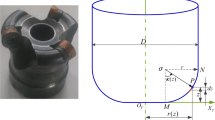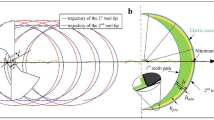Abstract
Surface topography is one of the most important factors which affects the equipment reliability and life. In order to study the various influence factors of surface topography in micro-side milling, a surface topography model was established which took into account of the machine tool system’s dynamic characteristic. Dynamic characteristic functions was obtained by Receptance Coupling method, and then combined with milling force model to calculate dynamic deflection of the cutter. A new surface topography model was proposed in which cutter deflection was introduced into cutting edge trajectory equations in micro-side milling. An orthogonal experiment was designed in which spindle speed, feed rate, radial depth of cut, and milling mode were chosen as the main influence factors. Then the influence on surface topography in micro-side milling was analyzed by experiment results and simulation model. The analysis results showed that the most important factors on surface topography in micro-side milling are spindle speed, feed rate, radial depth of cut, and milling methods.





Similar content being viewed by others
References
Liu Y, Li PF, Liu K, Zhang YM (2017) Micro milling of copper thin wall structure. Int J Adv Manuf Technol 90(1-4):405–412
Martellotti ME (1941) An analysis of the milling process. Trans ASME 63:677–700
Elbestawi MA, Ismail F, Yuen KM (1994) Surface topography characterization in finish milling. Int J Mach Tools Manuf 34(2):245–255
Kline WA, DeVor RE (1983) The effect of runout on cutting geometry and forces in end milling. Int J Mach Tool Des Res 23(2-3):123–140
Sutherland JW, DeVor RE (1986) An improved method for cutting force and surface error prediction in flexible end milling systems. J Eng Ind ASME 108(4):269–279
Kolarits FM, Devries W (1991) A mechanistic dynamic model of end milling for process controller simulation. J Eng Ind Trans ASME 113(2):176–183
Yan B, Zhang DW, Xu AP, Huang T, Zeng ZP (2001) Modeling and simulation of ball end milling surface topology. J Comput-Aid Desig Comput Graph 13(2):135–140
Xu A P, Zhang D W, Huang T, Qu Y X (2000) Physical simulation model for peripherally milled surface topography considering the cutter flexibility. J Comput-Aid Desig Comput Graph 12(4):262–266
Vogler MP, DeVor RE, Kapoor SG (2004) On the modeling and analysis of machining performance in micro-end milling, part i: Surface generation. J Manuf Sci Eng ASME 126(4):685–694
Wang W, Kweon SH, Yang SH (2005) A study on roughness of the micro-end-milled surface produced by a miniatured machine tool. J Mater Process Technol 162-163(15):702–708
Li CF, Lai XM, Li HT, Ni J (2008) Physical simulation model for meso-scale milled surface topography. J Simul 20(4):846–849
Li CF, Lai XM, Li HT, Ni J (2007) Modeling of three-dimensional cutting forces in micro-end-milling. J Micromech Microeng 17(4):671–678
Han ZY, Zhang X, Fu HY, Sun YZ (2012) Receptance coupling for micro-end-milling. Adv Mater Res 472-475:2391–2396
Vogler MP, DeVor RE, Kapoor SG (2001) Microstructure-level force prediction model for micro-milling of multi-phase materials. J Manuf Sci Eng Trans ASME 125(2):202–209
Funding
This work is financially supported by the National Natural Science Foundation of China (NSFC, No.51605118) and the Fundamental Research Funds for the Central Universities (Grant No. HIT.NSRIF. 2016042).
Author information
Authors and Affiliations
Corresponding author
Additional information
Publisher’s note
Springer Nature remains neutral with regard to jurisdictional claims in published maps and institutional affiliations.
Rights and permissions
About this article
Cite this article
Zhang, X., Pan, X. & Wang, G. Influence factors of surface topography in micro-side milling. Int J Adv Manuf Technol 105, 5239–5245 (2019). https://doi.org/10.1007/s00170-019-04527-y
Received:
Accepted:
Published:
Issue Date:
DOI: https://doi.org/10.1007/s00170-019-04527-y




